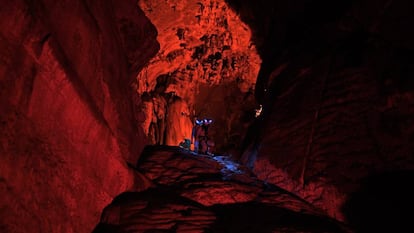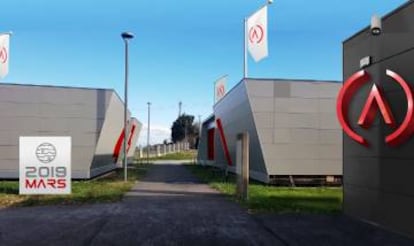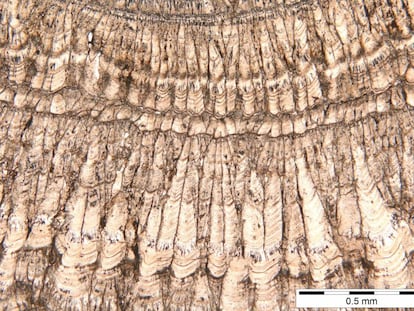Want to experience life on Mars? Head for northern Spain
A Spanish company is launching a scientific tourism project involving a mock-up of a Martian colony inside a cave in Cantabria


At the FITUR tourism fair held in Madrid last week, the head of industry, trade and tourism for the northern region of Cantabria, Francisco Martín, allowed himself to get carried away: “An increasingly infinite Cantabria now reaches as far as Mars,” he stated at the presentation of a new project named Astroland.
Participants will be taught skills that include caving, climbing and hydroponics
A meeting point between science and tourism, Astroland promises to replicate the conditions of a human colony on Mars, except this mock settlement happens to be inside a cave in Arrendondo, at the foot of green hills and a stone’s throw from the fish-filled waters of Santoña, rather than on a hostile, atmosphere-free planet located around 225 million kilometers from Earth.
Funded by €2 million of private investment, Astroland is the brainchild of Banco Santander’s business incubator and should be open to space “travellers” – or crew, as Astroland CEO David Ceballos calls them – by June 15 of this year. The idea is to send 10 missions with 10 people on each one by the end of the year. But it’s not exactly a family vacation. Participants must be over 18 and willing to fork over €10,000 per person. Moreover, there is a selection process that begins with registration on the website www.astrolandagency.com.
Life on Mars
To be one of these pioneers, participants will be taught skills that include caving, climbing and hydroponics, or the cultivation of plants in a nutrient-rich, water-based solution. Training sessions, which are covered by the €10,000 fee, also include psychology, coaching and contingency plans – everything that would make life on Mars possible.

The cave in Arredondo is 1.5 km in length and 60 meters high. Inside are high-pressure capsules that will serve as laboratories and bedrooms. Clean-energy sources will be used and the air will be purified in the same way as it would be if it were a cave on Mars. “Getting the licenses has been the most costly part of the project,” admits Ceballos.
Cave life will be no walk in the park and, according to Ceballos, the idea is to test the technology that could very well be necessary on the real Mars one day, and to make breakthroughs that could be used on Earth, as Velcro was in its day.
Astrolanders will not be allowed to leave their capsules without first donning their polymer space suits, which were designed with the help of the University of Design, Innovation and Technology (ESNE) and which are anti-bacterial, flexible and resistant to abrasion. The helmet is currently being perfected. Before entering the capsules, the crew will have to go through a disinfecting unit.
A minimum three-day stay
Once “clean,” the crew will be monitored at all times and given different tasks to perform according to their skills from a control center in the Science and Technology Park of Cantabria, in Santander. “A kind of Houston,” jokes Ceballos.
In order to faithfully recreate the conditions on Mars, all communications will take eight minutes to reach the crew. Only one message per crew member is allowed to the outside world during their stay, which must be at least three days in length. Astrolanders will also be forced to wear special diapers that will be biodegradable to keep the human footprint on the cave – and on Mars – down to a minimum. In fact, studying the mechanics of this is the goal of the first mission.

But why a cave? Ceballos explains that any colony on Mars would have to be underground. “The surface of Mars is swept by fierce winds and the temperature is very low – around -60ºC – while the radiation is very high,” he says.
Ideally, a human settlement on Mars would live inside a lava tube underground. It is true that gravity in Arredondo is three times that on Mars, but then it is not possible to get everything right.
English version by Heather Galloway.
Tu suscripción se está usando en otro dispositivo
¿Quieres añadir otro usuario a tu suscripción?
Si continúas leyendo en este dispositivo, no se podrá leer en el otro.
FlechaTu suscripción se está usando en otro dispositivo y solo puedes acceder a EL PAÍS desde un dispositivo a la vez.
Si quieres compartir tu cuenta, cambia tu suscripción a la modalidad Premium, así podrás añadir otro usuario. Cada uno accederá con su propia cuenta de email, lo que os permitirá personalizar vuestra experiencia en EL PAÍS.
¿Tienes una suscripción de empresa? Accede aquí para contratar más cuentas.
En el caso de no saber quién está usando tu cuenta, te recomendamos cambiar tu contraseña aquí.
Si decides continuar compartiendo tu cuenta, este mensaje se mostrará en tu dispositivo y en el de la otra persona que está usando tu cuenta de forma indefinida, afectando a tu experiencia de lectura. Puedes consultar aquí los términos y condiciones de la suscripción digital.
More information
Archived In
Últimas noticias
Reinhard Genzel, Nobel laureate in physics: ‘One-minute videos will never give you the truth’
Pinochet’s victims grapple with José Antonio Kast’s rise in Chile
How Japan is trying to avert ‘digital defeat’
The complicated life of Francesca Albanese: A rising figure in Italy but barred from every bank by Trump’s sanctions
Most viewed
- Pablo Escobar’s hippos: A serious environmental problem, 40 years on
- Why we lost the habit of sleeping in two segments and how that changed our sense of time
- Trump’s obsession with putting his name on everything is unprecedented in the United States
- Charles Dubouloz, mountaineering star, retires at 36 with a farewell tour inspired by Walter Bonatti
- The Florida Keys tourist paradise is besieged by immigration agents: ‘We’ve never seen anything like this’










































